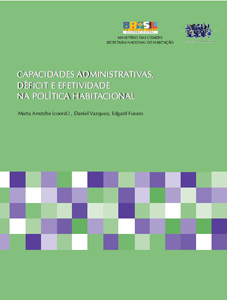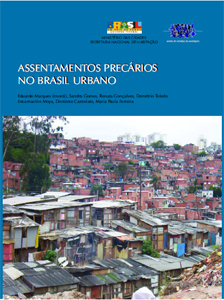Precarious housing/Administrative capacities
Two studies commissioned by the Brazilian Ministry of the Cities were developed by CEM. You can now download CEM’s studies on precarious housing and administrative capacities of Brazilian municipalities, or look for data related to your city or region (content in Portuguese only).
Click on the links to access:
"Dictionary of data on housing sectors": A pdf file with the dictionary of variables used in the study.
"Administrative Capacities, Deficit and Effectiveness in Housing Policy": A book on local governments' administrative capacities in the housing sector.

"Precarious Housing in Urban Brazil":A book on precarious housing in urban Brazil.

List of variables by municipality and region (Excel file)
INTRODUCTION
This site presents the results of the study conducted by the Center for Metropolitan Studies/CEBRAP, at the request of the Ministry of Cities.
The work resulted in two types of studies. The first, presented in the book "Precarious Housing in Urban Brazil," updated information on the housing needs of a selected group of municipalities, through the mapping of precarious housing. The second, presented in the book "Administrative Capacities, Deficit and Effectiveness in Housing Policy," evaluates all Brazilian municipalities, identifying their administrative capacity to deal with different types of housing needs, and measuring their housing programs and expenditures on housing.
The study on the estimates of precarious housing consists of the construction of population and cartographic estimates relating to slums, obtained with the development of statistical and mapping methodologies for a selected set of Brazilian municipalities, considering the urban census tracts and the urban extension of rural ones. This methodology identifies specific territories within cities, which could be considered precarious housing areas, and estimates the population that lives there, as well as the social characteristics of its inhabitants. This information is intended as an initial input for the planning of urban and housing policies for both the Ministry of Cities and for the local governments themselves. The results also represent an important starting point for building more accurate maps, developed at the local level from field checking or crossing with municipal registries. These results should not be understood, therefore, as a definitive registry, but as boundary estimates that circumscribe places where precarious housing is most likely to be located. This project involves efforts of this kind, produced on the national level with unique methodology and comparable results.
In general, the methodology starts from the only source of nationwide information that identifies existing poor housing areas within the municipalities, which may be regarded as slums—the so-called subnormal tracts of the IBGE demographic census of 2000. The subnormal tract is often used as a data source to identify precarious housing, but it has limitations. Such a definition is used by IBGE to make the census field possible, not having as a main objective, therefore, to establish a systematic survey of settlements of this kind. As a consequence, the definition of subnormal tracts eventually incurs various problems of underestimation.
The assumption of the present exercise of estimate is that, even though precarious housing is defined in the law, as well as in terms of urban and environmental services, the population that live there tends to be strongly correlated with certain social contents. Thus, it is possible to identify other census tracts which, although not categorized as subnormal by the census, have social-housing contents similar to the residents of subnormal sectors.
Because there is, in the Brazilian context, a wide variety of living conditions, population sizes, etc., depending on geographic location, the estimate of precarious housing was based on a regionalization of municipalities in 21 major conglomerates, with a special attention to metropolitan areas.
The site includes links to files containing results by Municipality and State of the Federation or by Metropolitan Region (MR). When the city or MR of interest is found, the user has access to a compressed file containing the geographic file that enables the creation of thematic maps of the tracts classified as precarious, or the user can access only the tabular data, in the format “dbf.” The sum of subnormal tracts (according to IBGE’s definition), with the tracts classified by statistical analysis, forms an overall estimate of precarious housing in a given county or MR. Other descriptive variables were added, such as the total resident population, income and education of household heads and access to services of urban infrastructure. To identify all available information in the files, just check the dictionary of variables. Maps showing the national and regional level were also included.
The quantitative estimates of the phenomenon included 561 municipalities, comprising all metropolitan areas, besides all others with a population over 150,000 inhabitants in 2000. Among these, intra-municipal maps with precarious housing delimitation were produced for 371 municipalities.
The study on the administrative capacity of Brazilian municipalities produced a detailed and spatialized diagnosis on these capabilities, linking them to the deficit of municipalities with more than 20,000 inhabitants, as well as housing programs that have been implemented and were effective, and potential capacity for spending on housing in all Brazilian municipalities.
Using statistical analysis (multivariate and clustering), we developed a typology using all Brazilian municipalities as a sample, and were able to identify (based on information about the existence of specialized organs in the management of housing programs, registration for identification of beneficiaries, as well as councils, housing funds and consortia) the administrative capacity installed to produce housing programs. The assumption—confirmed by the study—is that the capacity of municipalities to produce different types of housing services is directly affected by the existence of such administrative capacity.
The data source used, the most comprehensive available on this subject, consisted of all the editions of the Survey on the Profile of Brazilian Municipalities, IBGE (1999, 2001, 2002, 2004 and 2005), which reveal the existence, density and stability of these capabilities in Brazilian municipalities.
The study also constructed a typology of Brazilian cities with populations exceeding 20,000 inhabitants, according to the characteristics of its housing deficit, disaggregating them into different situations of the basic housing deficit, which would require the construction of new housing and the housing deficit by inadequacy of the home, which would require programs to improve housing.
This new typology allows, therefore, crossing information about different types of deficit with information about the administrative capacity of all Brazilian municipalities with a population over 20,000 inhabitants.
The effectiveness of housing policies in the universe of Brazilian municipalities was also analyzed in this work, using as parameters the housing programs implemented by municipalities and municipal spending on housing. This analysis is based on information from successive editions of the Research Profile of Brazilian Municipalities as well as on data from the National Treasury. The intersection of information about programs implemented and spending on housing allows the reader to identify different situations of the effectiveness of housing policy, with disaggregated information and spatialized by municipality.
Finally, the study examines the potential for expansion of municipal spending on housing, based on a survey of revenue potential of municipalities.
In the book, statistical attachments of the study are available, as well as a listing of all the municipalities present in the study, organized by state. This listing presents the characteristics of each municipality in terms of the attributes for which we collect information, as well as for attributes developed throughout the study. The attributes for each municipality are: region, location, belonging (or not) to the Metropolitan Region (MR), Integrated Development Region (IDR), urbanization rate in 2000, age groups of the population in 2004, estimated population in 2006 and 1999.
TEAM
Federative Republic of Brazil
- President of the Republic:Luiz Inacio Lula da Silva
- Vice President: José Alencar Gomes da Silva
Ministry of Cities
- Minister of State: Marcio Fortes de Almeida
- Executive Secretary: Rodrigo José Pereira Leite Figueiredo
- National Secretary of Housing: Inês Magalhães
- National Secretary of Environmental Sanitation: Leodegar da Cunha Tiscoski
- National Secretary for Transport and Urban Mobility: Luiz Carlos Bueno de Lima
- National Secretary for Urban Programs: Benny Shasberg[/ i]
National Department of Housing
- Director of the Department of Institutional Development and Technical Cooperation: [i]Júnia Santa Rosa
- Director of the Department of Housing Production: Daniel Vital Nolasco
- Director of the Department of Precarious Housing: Mirna Quinderé Belmino Chaves
Center for Metropolitan Studies (CMS / Cebrap)
Coordination
- Eduardo Marques (Precarious Housing) and
- Marta Arretche (Administrative Capacity)[/ i]
Team:
- [i]Daniel Vazquez
- Sandra Gomes
- Renata Rocha Gonçalves
- Demetrius Gaspari Cirne de Toledo
- Encarnación Moya
Statistical Analysis:
- Maria Paula Ferreira
- Edgard Fusaro
- Elaine Minucci
Cartography:
- José Donizete Cazzolato
- Bruno Oliveira e Souza
Database and Web Site:
- Julio Cesar da Costa
- Carolina Leal Simonetti



